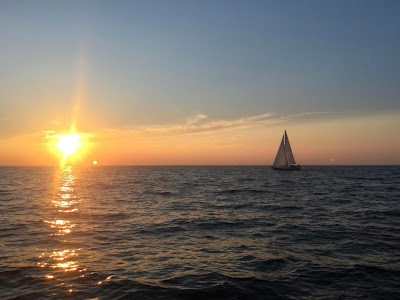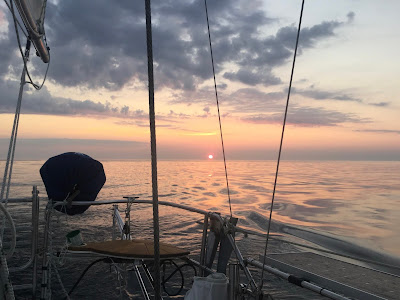We enjoyed the sunset on the Bohemian River and before turning in, we consulted Eldridge for the tides and listened to the weather forecast to plan the following leg of our trip. There was a front coming in with possible afternoon thunderstorms so we decided to take advantage of the fair current and catch the tide before dawn. We did not want to leave too early as the extreme summer rains had resulted in very large quantities of debris in the Chesapeake Bay. We had seen pictures of Ego Alley in Annapolis chock full of tree logs and other debris and the State of Maryland had spent millions of dollars removing debris from the Bay.
At 4 am we got up and before 5 am we were raising the anchor. There was an old crab pot that was caught around the anchor and we had to get that untangled as well as a large branch we had also picked up. With the anchor free and secured at the bow and with favorable current we started heading south. It was dark and calm. We had the RADAR going and had our eyes scanning forward as we were concerned about hitting floating debris.
We were motoring at four knots (7.5 km/hr) at slightly over idle as we had a fair current of almost two knots (3.5 km/hr). We stayed in the shipping channel and also kept an eye out for commercial shipping. There was lots of debris in the Bay, small branches bundled together in clusters 3 to 5 feet (1 to 1.5 meters) across. Shortly before dawn we spotted a large debris raft made up of three logs in the shipping lane. This collection of debris was approximately 30 by 40 feet (9 by 12 meters). We veered to starboard, and after passing it, contacted the Coast Guard to report it. For the rest of the day we kept hearing the Coast Guard broadcast the hazard on VHF Channel 16 every hour.
The sun came up and we were treated to another beautiful sunrise; this is one of the perks of early departures after all!
 |
| Sunrise, Chesapeake Bay |
We continued south and by mid-day we were approaching the Bay Bridge and we got a sense that this year’s cruise was coming to a close.
 |
| Approaching the Bay Bridge, Chesapeake Bay |
As we were ready to pass under the bridge, a 30 foot (9 m) aluminum power boat registered in Connecticut approached us and slowed down. The Captain leaned out of his pilothouse and called out to us, “Is that Rosalind?” We replied, "Yes" and then he added, “She looks really nice!” The Captain was Rosalind’s previous owner! We spoke for a few minutes and took pictures of each other’s boat before the Captain sped away. It had been an exciting and unexpected encounter!
 |
| A Chance Encounter with Rosalind's Previous Owner, Chesapeake Bay |
A few minutes later we heard reports of a collision between a fishing boat and a sailboat on the Bay. We were too slow to offer assistance, however there were several powerboats in the area that got to the scene. It was unclear from the radio chatter exactly what had happened. It sounded that fortunately there were no serious injuries. The next report confused us: “The boats are drifting together north on the Bay.” This report only made sense about 30 minutes later when we passed both boats about one mile (2 km) north of Thomas Point Light. The Coast Guard was getting to the scene and they were trying to determine where the passengers and captains of the two boat were. We could see a 30 foot (9 m) powerboat on top of a 30 foot (9 m) sailboat. It was truly miraculous that no one got seriously hurt, at least this is what was said on the radio.
 |
| Collision, Chesapeake Bay |
We continued on. The weather forecast had called for a Small Craft Advisory starting at 2 pm. A front was on its way with possible thunderstorms. We had passed Thomas Point Light and the wind started to pick up. We knew that we could not make it to Herrington Harbor North in time so we turned to starboard and headed for the West River. We called Hartge Yacht Harbor and let Buddy, the Harbormaster, know that we were on our way.
At 2 pm we picked up our mooring and turned off the engine. It has been a great trip and a wonderful season. We had visited new cruising grounds and had covered over 1000 miles (1850 km) at about 5 miles per hour (9 km/hr). We made new friends and met up with family and old friends. Rosalind had taken care of us and we had done our best to take care of her.
We planned on keeping Rosalind at her mooring for a while and then hauling and getting ready for next season but Mother Nature had other ideas...Hurricane Florence formed and started heading towards the East Coast of the US. So, we moved Rosalind to Herrington Harbor North to be hauled for the storm. Luckily for us in the Chesapeake Bay, the storm track changed and the hurricane missed us.
 |
| January 2019, Rosalind Snow-Covered and Awaiting her Next Voyage |
Thank you for following us along on our 2018 one thousand mile (1850 km) cruise. We will update you as the plans develop for our next voyage. Fair winds and following seas to you.







